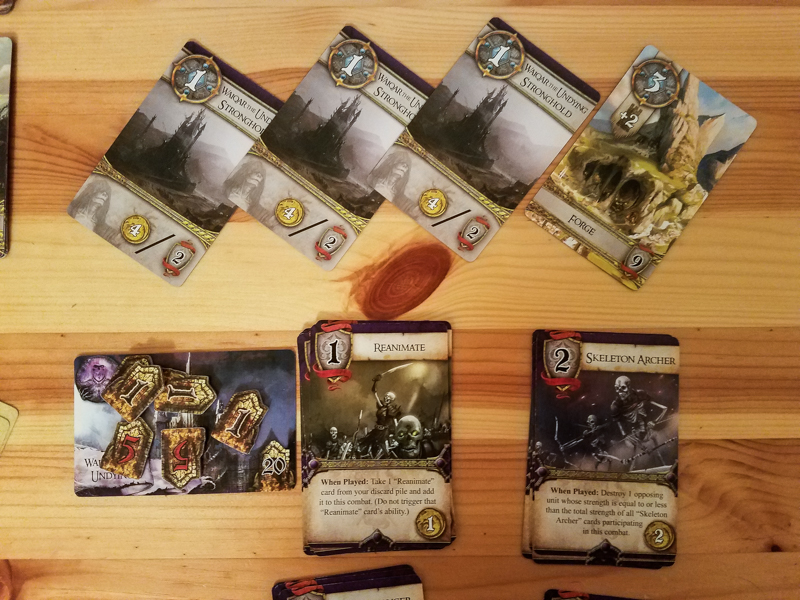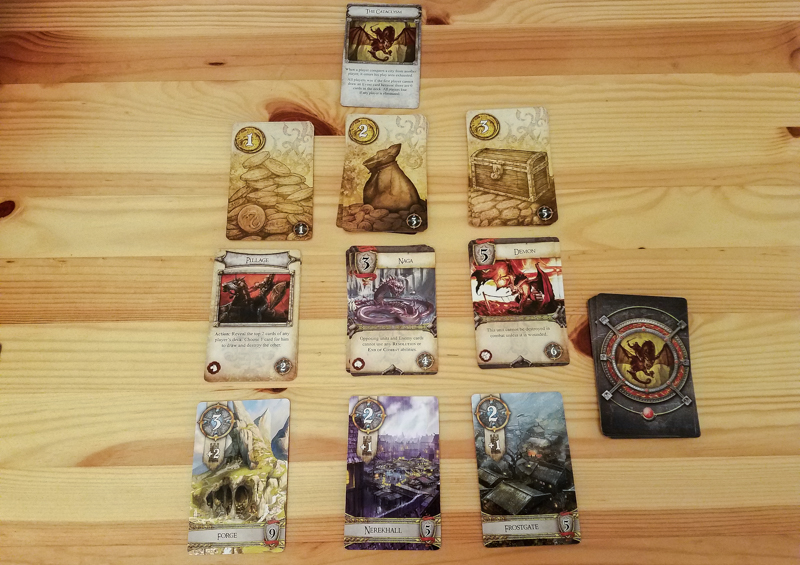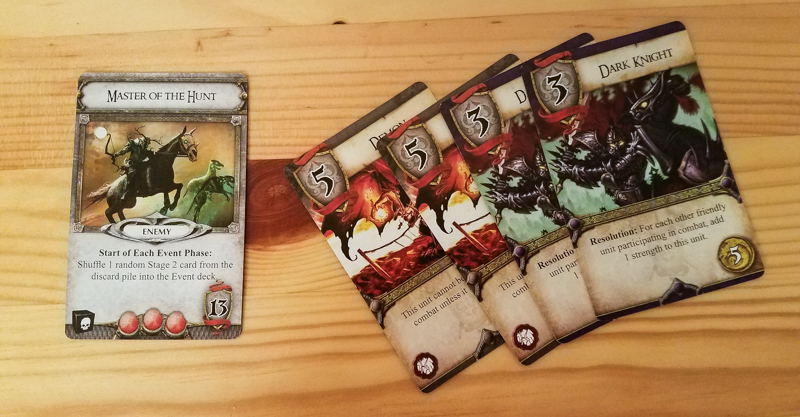Rune Age Review
Year: 2011 | Players: 1-4 | Minutes: 60+ | Ages: 14+
This Rune Age review was made after playing the game about 20 times.
What is Rune Age?
Rune Age is a fantasy deck building game in which players control different races and attempt to satisfy different win conditions depending on the scenarios they choose to play. In the co-op scenario, players work together to try to get through a series of events before anyone’s Home Realm is destroyed. This game is set in Terrinoth, which is the same world used in games like Descent, BattleLore, and Runewars.
Rune Age was designed by Corey Konieczka and published by Fantasy Flight Games.
Rune Age Gameplay
I’ll mostly only be going over the rules for the co-op scenario (‘The Cataclysm’) here, but I will touch on the differences between the four different scenarios you’ll get in the box.
In each game of Rune Age, players will have their own factions and their own Home Realms. Each of the four factions has its own set of four unit cards, which you’ll be able to buy and add to your deck. You’ll also be able to buy three strongholds, which you’ll place above your Home Realm after you buy them. The units are used to attack enemies and to secure cities, and you use the influence of the strongholds (and the cities you gain) to get more gold and neutral units.
You start with five 1-gold cards and three of your 1-cost unit cards in your deck and each turn you’ll be drawing five cards. As you add more cards to your deck, you’ll end up with much more powerful hands. If you’ve played Dominion, you’ll know exactly how this process works.
In the middle of the table will be gold cards (valued at 1, 2, and 3 gold), neutral units, and neutral cities that you’ll be able to buy throughout the game. Those neutral cities are great for giving your faction more influence and to defend your Home Realm.
On your turn you’ll be buying cards from your own Barracks (using gold) or from the neutral units (using influence), or you can attack the neutral cities or the enemies that come out of the Event deck (using strength). When you battle an enemy, you’ll be using the abilities and the strength values of your units to try to meet or exceed the strength value of the enemy. In many cases you’ll have to roll the attrition die to see if the enemy killed any of your units; if it did, you’ll remove those enemies from the battle and then check to see if you won the battle.
After all players have taken a turn, you’ll draw an event card from the Event deck. Some of these cards will be enemies and others will be Instants. Instants are cards that immediately affect the game in some way. Enemies will stay in play until they are defeated.
In co-op mode, you’ll win the game if you’re able to draw all of the Event cards before anyone’s Home Realm is destroyed. You don’t have to defeat all of the enemies to win.
There are three other game modes that you can play:
- Resurgence of the Dragonlords – The first player to defeat the main enemy is the winner. Players can attack each other in this mode.
- Runewars – This is the King of the Hill mode. You’ll be trying to take out everyone else’s Home Realm and be the last faction standing.
- The Monument – In this competitive scenario everyone will be racing to build monuments. You get your own monument card and will try to get the gold you need to purchase it.
Pros and Cons
Pros
- Easily the best thing about Rune Age is the fact that you get four game modes in one box. There are even solo rules for a couple of the scenarios.
- All four of the factions have their own look and feel to them. It’s a lot of fun learning how to play the different factions and to see some of the cool combos in action.
- The artwork on the cards is very nice, which isn’t surprising considering this game was published by Fantasy Flight.
- All of the Rune Age scenarios are extremely easy to learn and teach. This is a very good gateway deck builder.
- I also really like that the game only takes a couple of minutes to set up, which is something I can’t say about most deck builders.
Cons
- In co-op mode, Rune Age’s replayability is pretty low. You’ll face the same boss and the exact same Event cards every time you play, so once you figure out the puzzle, your win rate is going to be quite high. This isn’t as much of a problem in the competitive modes because you’re playing against the game and the other players.
- Some faction cards have abilities that do absolutely nothing in co-op mode. You really just buy them for their strength values.
- Factions should have come with more than four sets of units to buy. The expansion does add in additional units for each faction, but there really should have been more in the base game.
- Each scenario only has three neutral cards to buy, and you always use the same ones. That’s okay during the first few games, but after a while you really do want more options.
Final Thoughts
Rune Age isn’t a great game, but I’ve kept it on my shelf the last couple of years because it’s simple to teach and it has four different ways that you can play it. It’s actually worked quite well as a gateway deck builder and the competitive modes are pretty solid. In fact, I’d say the three competitive scenarios are all quite a bit better than the co-op scenario.
I wouldn’t put Rune Age up there with the best deck building games, so if you’re specifically looking for any great deck builder, you do have some better options. If you want a light fantasy deck builder that plays similarly but gives you much more replayability, I’d recommend checking out The Red Dragon Inn: Battle for Greyport. Heavier fantasy deck builders my group enjoys playing include Aeon’s End, Dragonfire, and Shadowrift 2nd Edition.
Rune Age Links
BGG | Amazon | eBay
Thanks for taking the time to read our Rune Age review!
To stay updated on all things cooperative board games, follow us on Twitter, Facebook, or via RSS.




